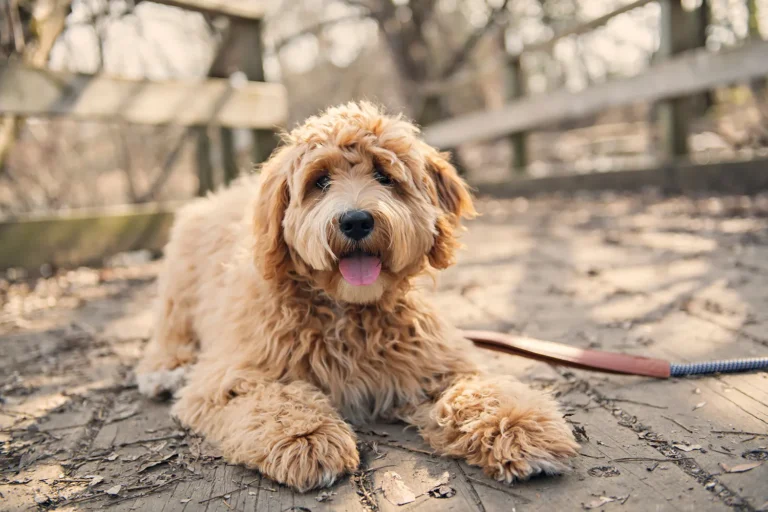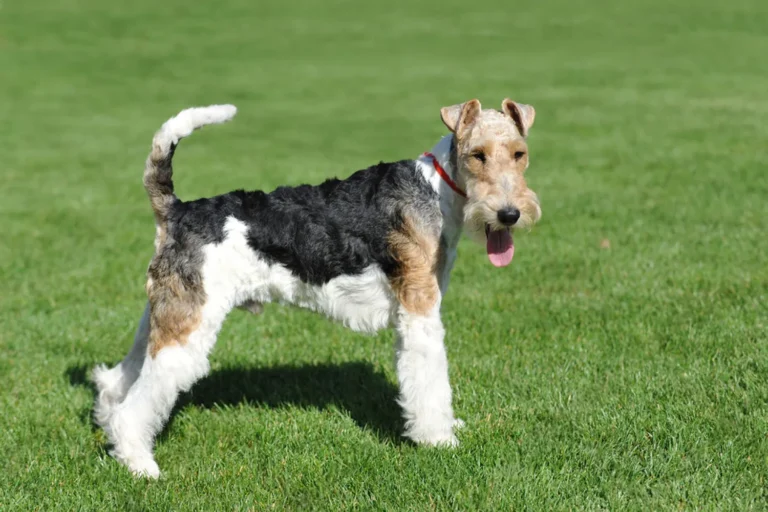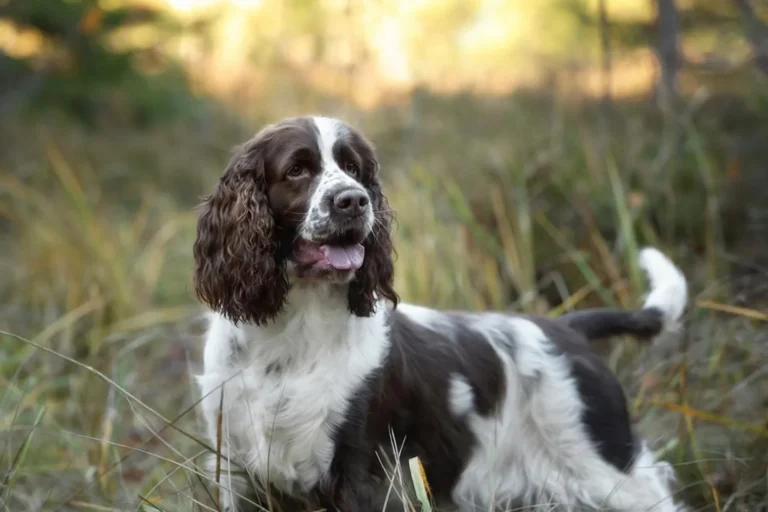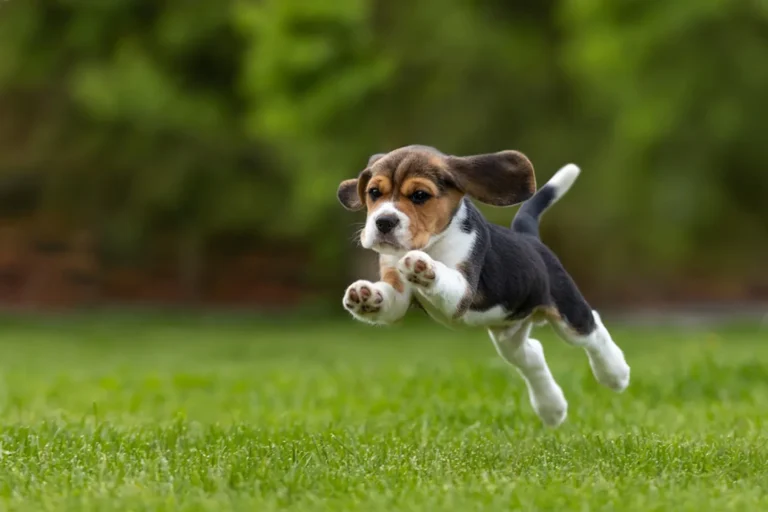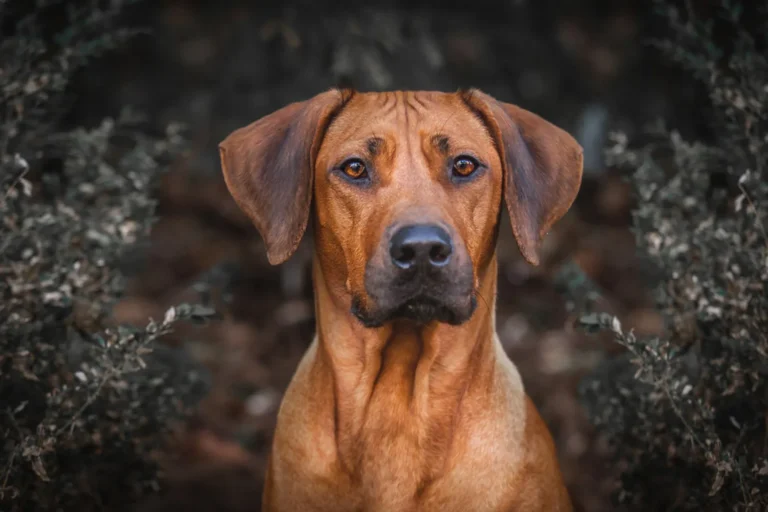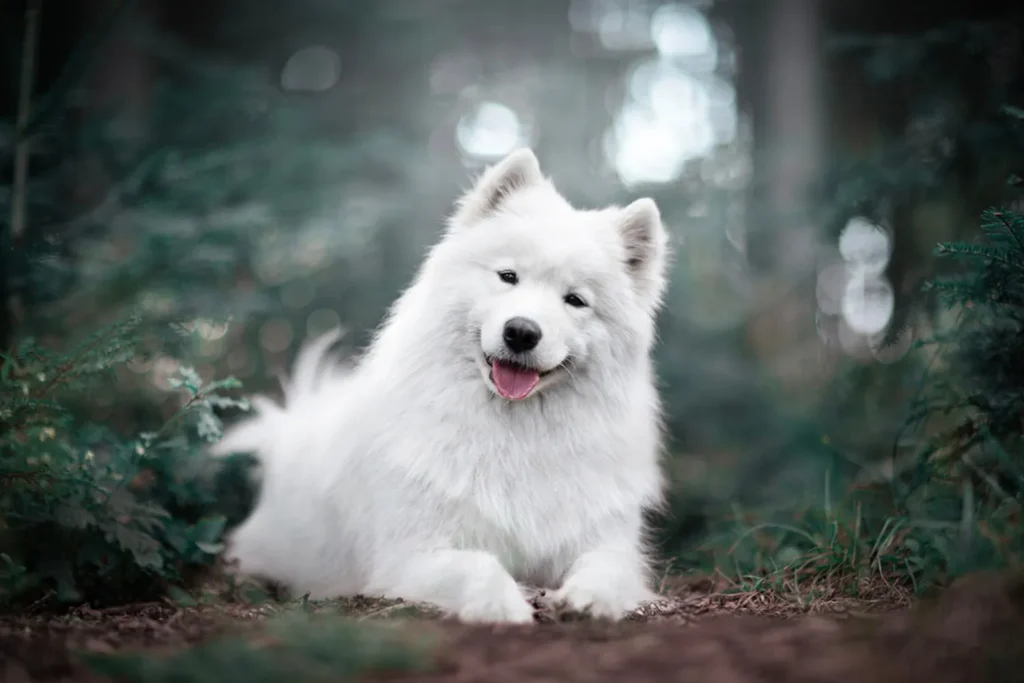
If you’re dreaming of a friendly, fluffy dog to join the family, a Samoyed might just be your perfect match. They’re famous for that “Sammy smile,” and honestly, it’s hard to have a bad day when one of these walking snow clouds is grinning up at you. I once dog sat my neighbor’s Samoyed, and he greeted me like we’d been best friends for years full body wag, happy chatter, and a head tilt that could melt anyone.
Just know that all that fluff comes with some upkeep. They shed a lot so a good brushing routine is your new best friend. They’re energetic, too, so plan on daily walks and a few goofy games to keep them content. Mine loved trotting along in cool weather and “helping” shovel snow by stealing the mittens. Training is fun with Samoyeds if you keep it positive and a bit playful; they’re smart, but they like to have a say. If you want a cheerful companion who thrives on family life and adventure, the Samoyed checks the boxes.
History and origin of the Samoyed
The story of the Samoyed starts far to the north, with the Samoyedic peoples of Siberia an old term Russians once used for several indigenous groups. These families bred their dogs to hunt reindeer and pull sleds, and because the dogs lived so closely with people, they were treated like treasured partners. I’ve heard breeders describe how the dogs would share tents in winter, keeping everyone warm and learning to trust humans completely. That easygoing, smiling expression Samoyeds are famous for feels like a souvenir from those long, shared nights by the fire.
As Arctic expeditions picked up steam in the 19th and 20th centuries, Samoyeds proved their worth hauling sleds across ice fields. They were hardworking, steady, and cheerful in the cold, which made them favorites of polar teams. From there, they made their way to the UK and the United States, where they quickly won hearts and a place in the show ring. The American Kennel Club registered its first Samoyed in 1906-I remember seeing a sepia photo of an early Samoyed team in a little maritime museum and thinking, of course these fluffballs were explorers.
Despite their snow drift coats, Samoyeds can adapt to warmer climates and do surprisingly well in places without winter. My neighbor’s Samoyed in San Diego is happiest on early morning beach walks, tail like a white flag. If you live somewhere warm, help them out: exercise at dawn or dusk, keep fresh water handy, brush that double coat so it can insulate properly, and give them shade or a cooling mat. Don’t shave the undercoat it’s their built in climate control. With a bit of common sense care, these Arctic sweethearts go from reindeer trails to city sidewalks without missing a beat.
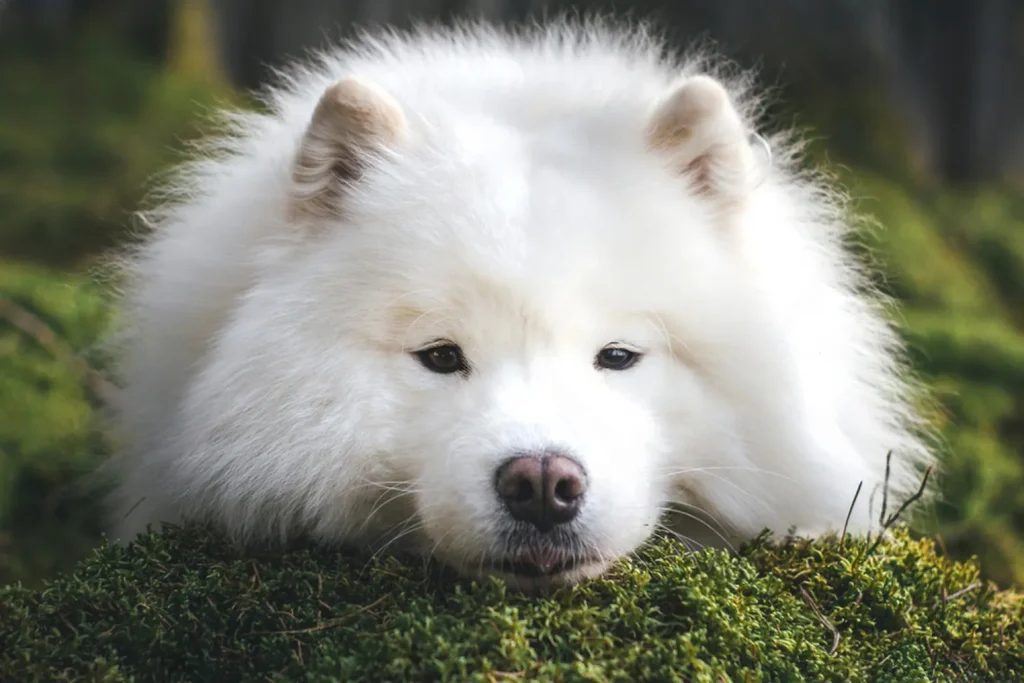
What Is the Samoyed Breed?
Picture a walking snow cloud with a permanent grin that’s a Samoyed. These medium sized charmers wear a thick, double layer coat that feels like spun wool and usually shines bright white. You’ll also see them in cream or a pretty “white and biscuit” mix that looks like someone dabbed honey on fresh snow. Their plumed tail usually curls over their back, and that famous “Sammy smile” isn’t just for photos; it’s part of their sunny, friendly nature.
Samoyeds are often considered hypoallergenic because they tend to carry less dander, which can make them a thoughtful choice for families with allergies. That said, I always suggest spending time with one first to see how everyone feels when my friend was deciding, we did a park meet up, a quick cuddle session, and a car ride home with the windows cracked. Between regular brushing, a good vacuum routine, and an air purifier, their household has been happily sniffle free.
Personality wise, Samoyeds are social butterflies. They greet neighbors like old friends and turn a simple walk into a parade of smiles. Thanks to those luscious coats, both puppies and adults look like plush toys come to life more than once I’ve buried my hands in a Sammy’s ruff and lost track of time (and, occasionally, a glove). Just be ready for coat care: a few thorough brush sessions a week keeps that fluff cloud under control and helps it stay clean and soft. They thrive on being part of the action, so include them in your day walks, games, even a chat while you make coffee. Keep them cool in warm weather, give them plenty of companionship, and you’ll have a joyful, photogenic partner who makes every errand feel like an event.
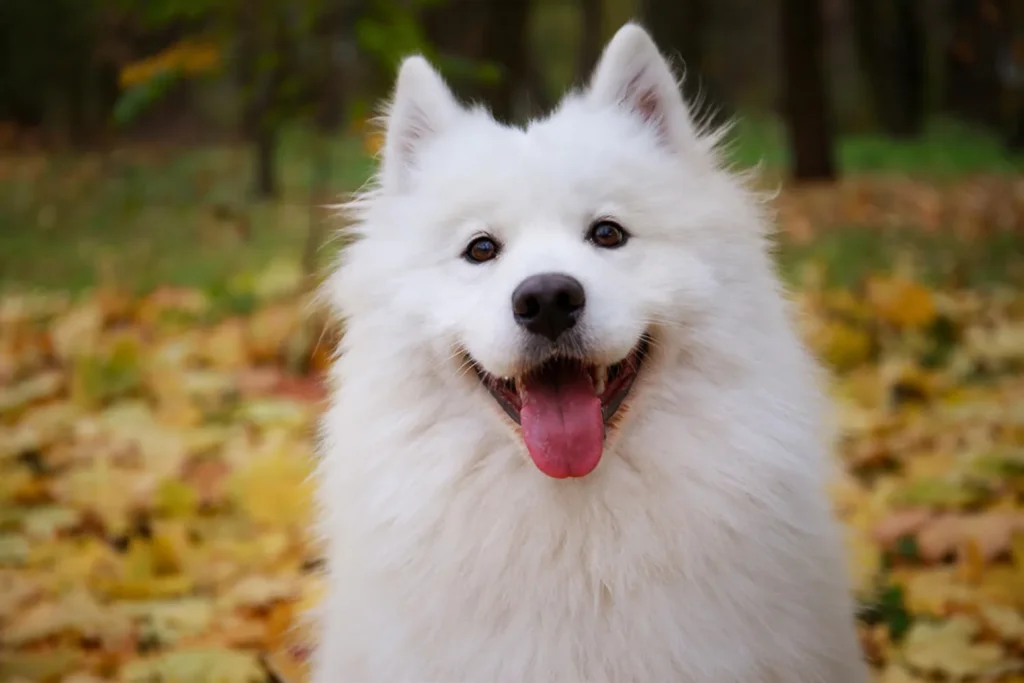
Who Is a Samoyed Best For?
If you want a cheerful, people loving companion who sees every day as a party, a Samoyed might be your kind of dog. They’re famously friendly and fit beautifully into family life, especially in homes that have time to include them in everything. I’ve watched a friend’s Sammy gently trail her toddlers from room to room like a fluffy guardian, then switch to full on playmate in the yard. They’re social butterflies, so they do best where someone’s around and happy to engage.
They’re also very smart clever enough to learn fast and, if you’re not paying attention, to teach you a few tricks instead. Because of that, Sammies are generally a better match for experienced owners who enjoy training and can keep sessions upbeat and consistent. Think puzzle toys, scent games, and short, frequent lessons. In one class I took, a Samoyed figured out how to tap the treat dispenser with his nose before the trainer even finished explaining the exercise. We had to get creative to stay one step ahead!
Activity wise, remember their roots as sled dogs. They’re energetic, hardy, and happiest with plenty of daily exercise in all kinds of weather. If you like brisk walks at dawn, weekend hikes, or even dabbling in dog sports, they’ll be right there, grinning through rain and snow. I once met a Samoyed on a sleety trail who looked like he’d booked the weather himself. A yard is a bonus, but dedicated outdoor time matters more.
A quick reality check: they’re not the best pick for a low key, couch only lifestyle. If you’re new to dogs, it’s still possible just line up a good trainer and be ready to invest in routine, enrichment, and exercise. And be prepared for that glorious coat; regular brushing is part of the package. For active families or individuals who love being outside and enjoy a smart, involved partner by their side, a Samoyed can be a dream.
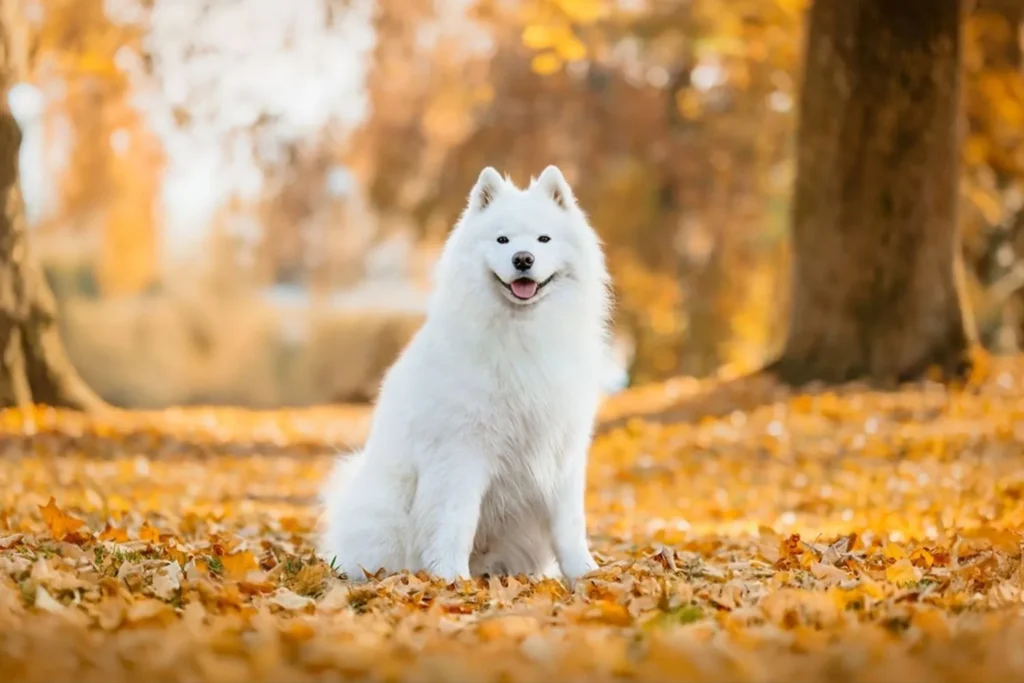
Samoyed Grooming and Shedding
Samoyeds shed all year, and then they really turn it up in spring and autumn when they “blow” that woolly undercoat to get ready for the next season. During those big molts, I brush daily if I can; the rest of the year, a thorough weekly session keeps tangles and mats from sneaking in. A slicker brush and an undercoat rake are my go to combo, and I like to “line brush” from the skin out in small sections so I don’t miss the fluff hiding underneath. I learned the hard way that a quick surface pass just smooths the top meanwhile the undercoat is plotting knots. Keep a lint roller in the car and on the hallway table; trust me on that one.
Bathing every six weeks or so is plenty unless your Samoyed finds a mud puddle (which, in my experience, they consider a personal challenge). Because they’re double coated, the bath and dry matter just as much as the brush. Rinse, rinse, and rinse again to get shampoo out of that thick undercoat, then dry all the way through damp undercoats can cause skin issues and invite matting. A high velocity dryer is a game changer; the first time I used one, I watched a snowstorm of white fluff fill the yard and wondered if I should start knitting. Avoid over bathing so you don’t strip their natural oils, and don’t shave a Samoyed unless a vet says it’s medically necessary their coat insulates against heat and cold.
That glorious white coat looks ethereal, but it does have a mind of its own. Loose hairs drift like dandelion fluff, and the undercoat can felt if ignored. A professional groomer who understands double coats is worth their weight in gold, especially during shedding season. I like to schedule a pro tidy up at the start of spring and fall to reset the coat and keep skin happy. At home, make grooming a positive ritual lots of treats, short sessions, and a comfy spot. Start early with puppies so the dryer noise and paw handling feel normal. Your floors may never be completely fur free, but with a routine, a good brush, and a sense of humor, your Samoyed’s sparkle more than makes up for the fluff.
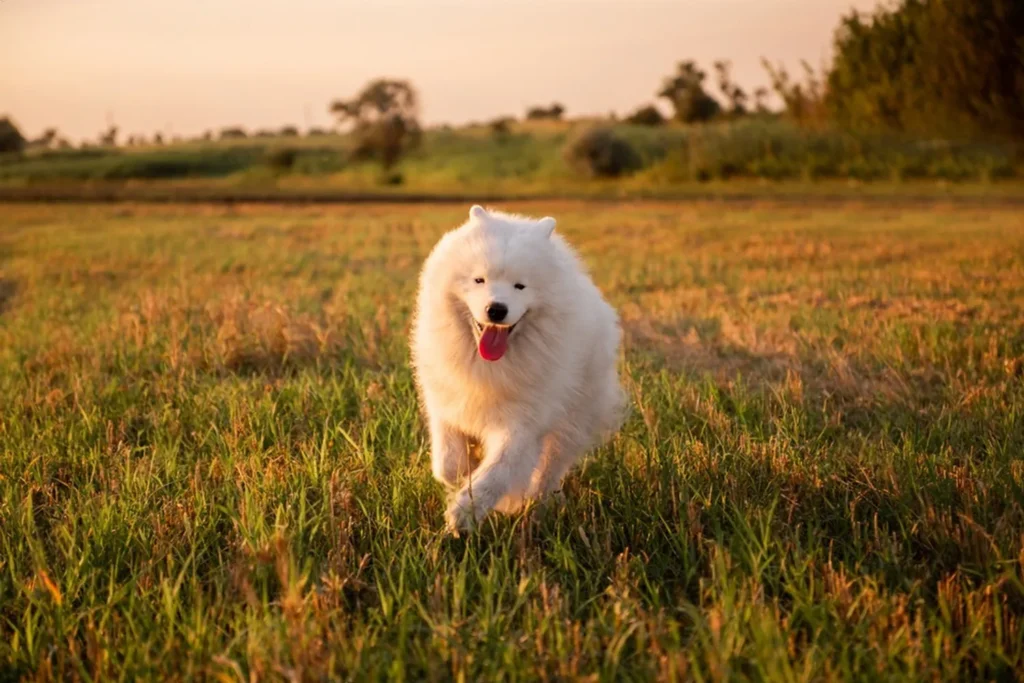
Do Samoyeds Bark a Lot?
Short answer: they can, especially if they’re distressed or left alone for long stretches. Samoyeds are clever, social dogs with big voices and even bigger feelings mine used to “woo woo” at the mail carrier like he’d discovered a long lost friend. When boredom sets in, the barking often follows.
Starting training young really helps. I had good results teaching a “quiet” cue, rewarding calm moments, and making sure we did a solid walk before I left the house. Puzzle feeders, stuffed Kongs, and a comfy safe space can take the edge off, too. If you live in an apartment, just plan ahead: talk to neighbors, keep a routine, and consider a midday dog walker or daycare.

What is the average weight and height of a Samoyed?
Samoyeds tend to hit their adult frame right around their first birthday. Most boys will settle between 20.5 kg and 30 kg, while girls usually land between 16 kg and 22.5 kg. Height wise, males stand about 53 to 60 cm at the shoulder, and females usually reach 48 to 53 cm. Don’t be fooled by that glorious cloud of fur under all that fluff is a well built, athletic dog. https://en.wikipedia.org/wiki/Samoyed_dog
Puppies grow fast, especially in the first six months. At around one month old, a Samoyed pup might be 2.25 to 4.5 kg. From there, expect roughly 2.25 kg of weight gain each month until the six month mark, when they typically weigh somewhere between 13.5 and 18 kg. After that, growth slows and they’ll gradually mature to their full size over the next six months. I remember taking weekly photos of my Samoyed on the same doormat; one day he barely covered the corner, and a few months later the mat looked like a postage stamp under him.
A couple of practical tips: measure height at the withers (the top of the shoulders). I lean my dog gently against a wall, place a book flat on his withers, and mark the spot to measure. For weight, the bathroom scale trick works step on with and without your dog and subtract. And if your pup’s numbers sit a bit above or below these ranges, don’t panic. Growth spurts are real, and every dog grows at their own pace. Focus on steady progress, a visible waist, and being able to feel ribs under that coat. When in doubt, a quick chat with your vet and a photo diary can give you peace of mind and a cute timeline of that fluffy glow up.
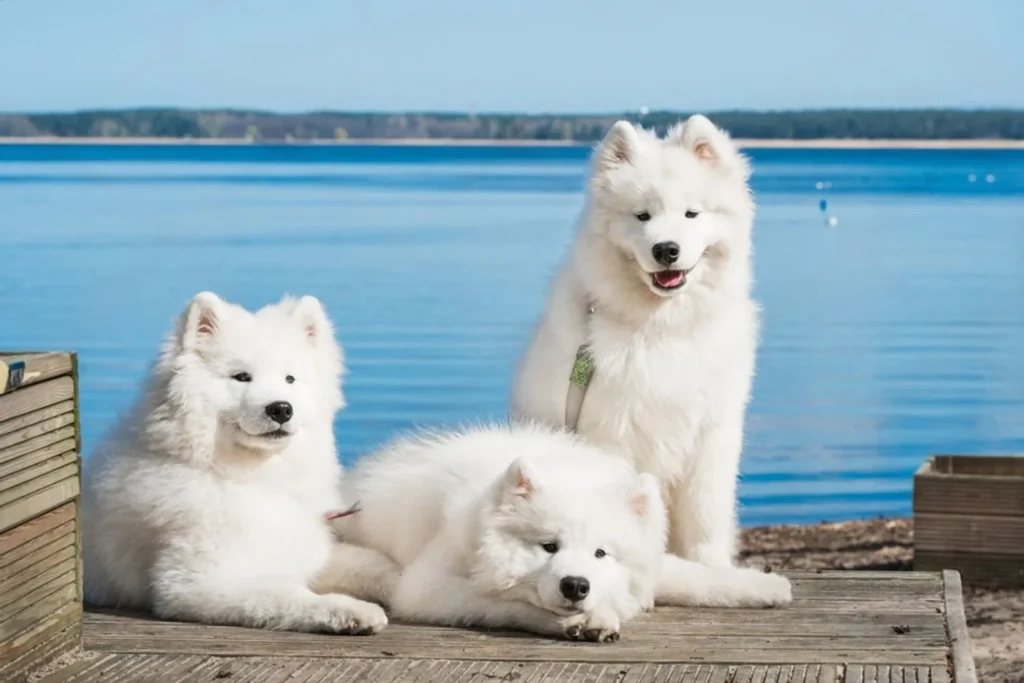
Are Samoyeds Easy to Train?
Samoyeds are wonderfully bright and just a bit opinionated, which makes training both fun and… let’s say, lively. Start the moment you bring your puppy home. Day one, I like to set simple routines sit before meals, wait at doorways, gentle paws on the floor for attention. Early training helps you set the tone and show your new fluffball what’s acceptable. My first Samoyed picked up “sit” in ten minutes but treated “come” like a negotiation for the first week smart dogs love to test the rules.
Consistency and patience are your best friends with this breed, but don’t forget to make it fun. Keep sessions short and upbeat five to ten minutes, a few times a day and end on a win. Be enthusiastic, praise generously, and reward good choices with treats or a favorite toy. I’ve had great luck with high value treats and a silly, happy voice. Samoyeds need to stay mentally busy to focus, so mix commands with games: a quick round of “find it” between sits, a puzzle feeder before practicing “stay,” or a trick of the day challenge. My friend’s Samoyed learned “spin” just because it made us laugh and suddenly “heel” got sharper too.
If your Sammy starts to check out, give a brain break: a sniffy walk, a chew, or a quick play session. Come back refreshed, and you’ll see the difference. With steady, positive training and plenty of mental exercise, these fluffy geniuses will meet you halfway and usually with a grin.
How do Samoyeds behave? A look at their temperament and personality
Samoyeds were bred to work, and you can feel that steady determination in the way they carry themselves. Underneath that famous smile, though, they’re big hearted softies friendly, gentle, and wonderfully loyal. My neighbor’s Samoyed, Nala, treats every passerby like an old friend and gently leans into you for a hello. It’s part of why they make such lovely family companions.
That working dog background also means there’s a strong willed streak. They’re smart enough to learn quickly, but also smart enough to ask, “What’s in it for me?” Kind, consistent training is key. I’ve had the best luck with short, upbeat sessions and tasty rewards. One afternoon in the park, I traded three tiny pieces of chicken for the most perfect sit while squirrels did their chaos routine proof that positive reinforcement wins the day.
Because they’re intelligent and energetic, Samoyeds need daily outlets for both mind and body. Think two good walks and a bit of play, plus some brain work. If you skip it, they’ll invent their own fun, which might involve “rearranging” your shoes. Regular walks and structured activities go a long way toward preventing boisterous or destructive behavior.
Mix in mental stimulation: puzzle feeders, sniffy “treasure hunts” around the yard, or a few new tricks each week. A friend in Minnesota taught his Sammy to pull a small sled at a slow, controlled pace just enough to give that working brain a job, and the grin afterward was priceless.
Around the house, expect an affectionate shadow. They usually blend beautifully into family life and adore being included. They can be chatty with a cheerful “woo woo,” so I like teaching a quiet cue early. With patience, exercise, and clear routines, that strong will turns into a steady, joyful partner who’s as sweet as they look.
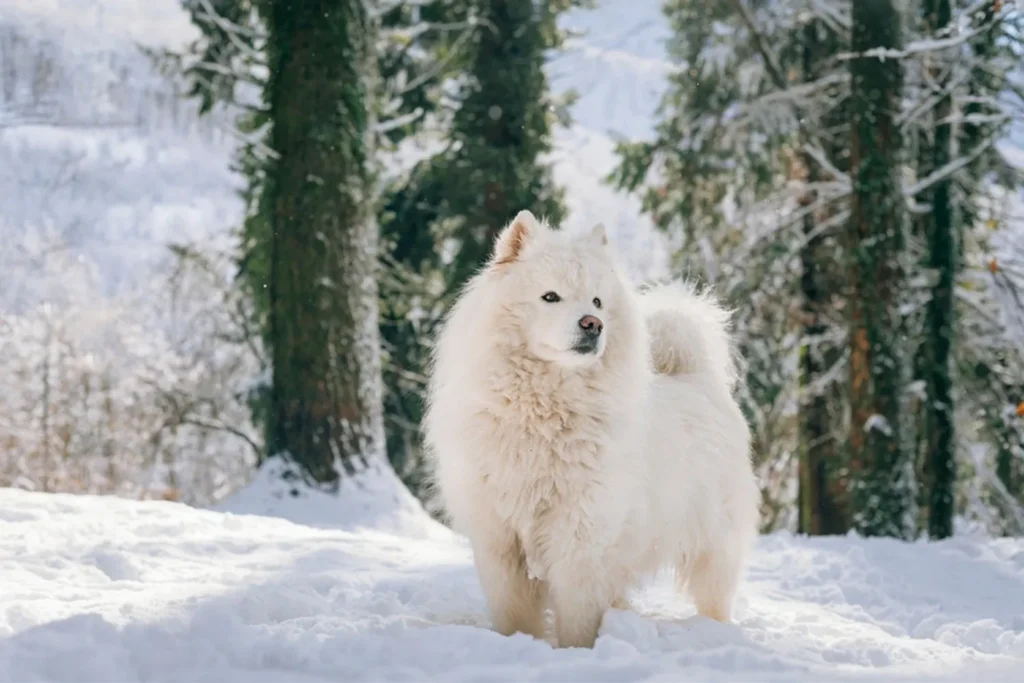
Do Samoyeds have common health issues?
Samoyeds are generally sturdy, cheerful snow clouds who stay healthy with good food, regular exercise, and routine vet visits. That said, no breed is totally “bulletproof.” Over the years, I’ve learned that a little prevention keeping them lean, checking eyes and ears during grooming, and not skipping annual checkups goes a long way. My friend’s Sammy, Nori, still powers through hikes at ten, and I’m convinced it’s because her family stayed on top of screenings and kept her weight in check.
Health issues reported in Samoyeds include:
– Hip dysplasia: A joint problem that can lead to arthritis and mobility issues. Keep them trim, build muscle with low impact exercise, and ask your vet about screening. I swear by ramps and rugs for slippery floors.
– Diabetes: A condition affecting blood sugar regulation. Watch for increased thirst, urination, or weight changes. Consistent meals and regular bloodwork, especially in middle age, help catch it early.
– Cancer: Like many breeds, Samoyeds can be at risk for various cancers. Do monthly “lump and bump” checks during brush outs and mention any changes to your vet right away. Early detection matters.
– Glaucoma: Elevated eye pressure that can lead to vision loss. Sudden eye redness, cloudiness, or squinting is an emergency don’t wait. Annual eye exams are a smart habit.
– Cataracts: Clouding of the lens that impairs vision. You might notice a gray blue haze or hesitance in dim light. Some cases are monitored; others may be candidates for surgery.
– Retinal dysplasia: A developmental change in the retina that can cause vision issues. Breeder eye screenings help reduce risk, and your vet can advise on management if it’s present.
– Vogt Koyanagi Harada (VKH) disease: An autoimmune condition affecting eyes and skin. Symptoms can include eye inflammation and pigment changes. It needs prompt veterinary care don’t “wait and see” on eye problems.
– Progressive retinal atrophy (PRA): A degenerative disease that can cause night blindness progressing to vision loss. There’s no cure, but dogs adapt well. I leave night lights on and keep furniture in the same spots to help navigation.
– Epilepsy: A neurological disorder causing seizures. If you ever see a seizure, time it, keep your dog safe from falls, and call your vet. Keeping a video log helps with diagnosis and treatment.
– Bloat (gastric dilatation volvulus): The stomach fills with gas and can twist this is life threatening and needs immediate care. Watch for a distended belly, unproductive retching, and restlessness. I feed measured meals, use a slow feeder, and avoid hard exercise right before and after eating.
– Kidney disease: Can show up as increased drinking, urination, or weight loss. Routine blood and urine tests catch changes early, and good dental care supports overall health.
A few practical tips from my routine: schedule an annual eye exam with a veterinary ophthalmologist, keep your Sammy at a healthy weight (you should feel ribs under a light layer), and build a relationship with your vet so you can text or call when something seems “off.” I keep an emergency clinic’s number on the fridge because when bloat or eye pain strikes, minutes matter. With a bit of diligence and lots of love, these fluffy comedians usually thrive for many happy years.
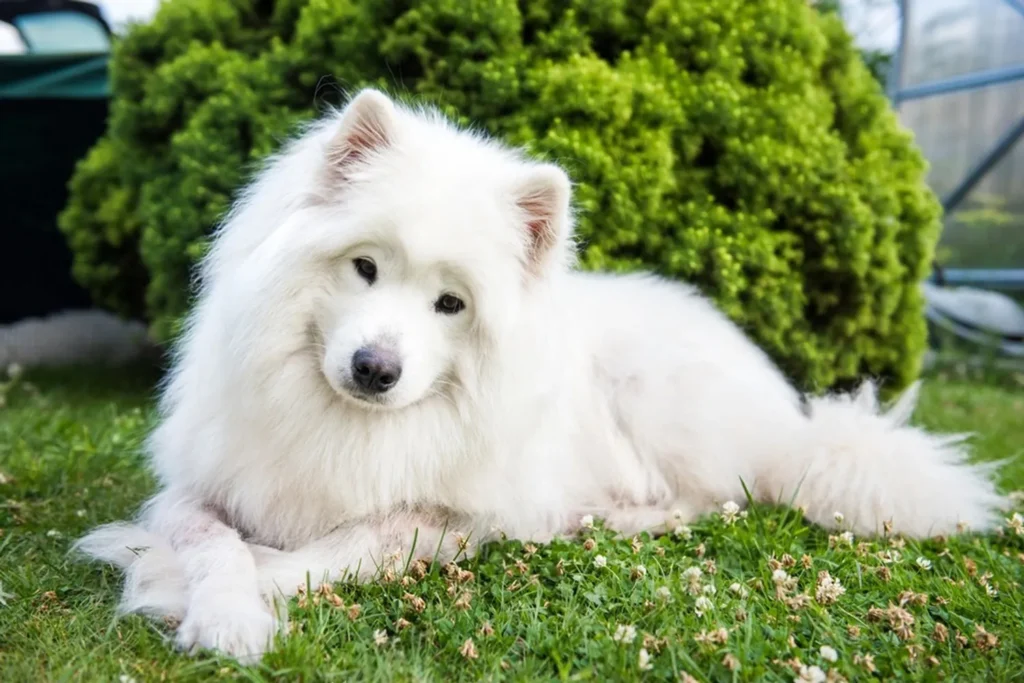
How Long Do Samoyeds Live?
Most Samoyeds share our lives for about 12 to 14 years, which is right on track for a medium sized dog. With thoughtful care, some even toddle happily past that. My neighbor’s fluffy snowball, Nika, turned 15 last winter we celebrated with a lazy walk in the cold and a very dignified extra treat.
The basics go a long way. Feed a balanced, high-quality diet and watch portions Samoyed fluff can hide extra pounds, so I do a quick “waist check” by feel every week. Keep them moving with daily walks, play sessions, and a bit of training to work that busy brain. Because of their thick coats, I plan the big exercise in the cool mornings or evenings and keep summer outings short. Regular vet visits matter too; I do yearly checkups for adults and switch to twice a year as they become seniors, along with dental care (my dog only tolerates chicken flavored toothpaste, but hey, it works). Brush that coat to keep skin healthy, trim nails, and consider joint friendly habits like rugs on slippery floors. Do those little things consistently, and you’ll give your smiling cloud the best chance at a long, happy life.
How much should a Samoyed eat?
Portion sizes depend on your Samoyed’s age, activity level, and metabolism, and they can change more than you’d think from season to season. My Sami hikes hard in the fall and needs a bit more, but in the summer heat she lounges like a fluffy rug and eats less. The key is to start with the feeding guidelines on your chosen dog food, measure portions with a cup, and then adjust gradually based on how your dog looks and feels.
For puppies, what you feed matters just as much as how much. Choose a reputable puppy formula designed for growth, with the right balance of protein, fat, and essential nutrients to build strong bones and healthy muscle. I like to feed puppies in three or four small meals so their energy stays steady and their tummies aren’t overwhelmed. Your vet can help track growth and tell you if you’re on target or if you should tweak portions or switch formulas.
Once your Samoyed is grown, aim for a healthy body condition: you should be able to feel ribs with light pressure but not see them, and there should be a gentle waist. If your dog’s getting a bit fluffy in more ways than one, trim back the food slightly; if they’re looking lean and logging extra miles, bump it up a touch. Two meals a day works well for most adults, and fresh water should always be available.
Avoid feeding human foods and table scraps. Not only can some foods upset their stomach, it can turn them into picky eaters. I learned the hard way after “just a few” pizza crusts my dog gave me the stink eye and ignored her high-quality kibble for two days. Keep treats modest (I stick to under 10% of daily intake) and use part of their regular food for training.
And don’t go it alone. Food brands provide helpful starting amounts, but regular check-ins with your vet are gold. Bring notes on appetite, energy, and weight; they’ll flag any needed dietary changes as your Samoyed grows, settles into adulthood, or heads into their senior years. Feed the dog in front of you, adjust slowly, and you’ll have a healthy, happy cloud by your side.
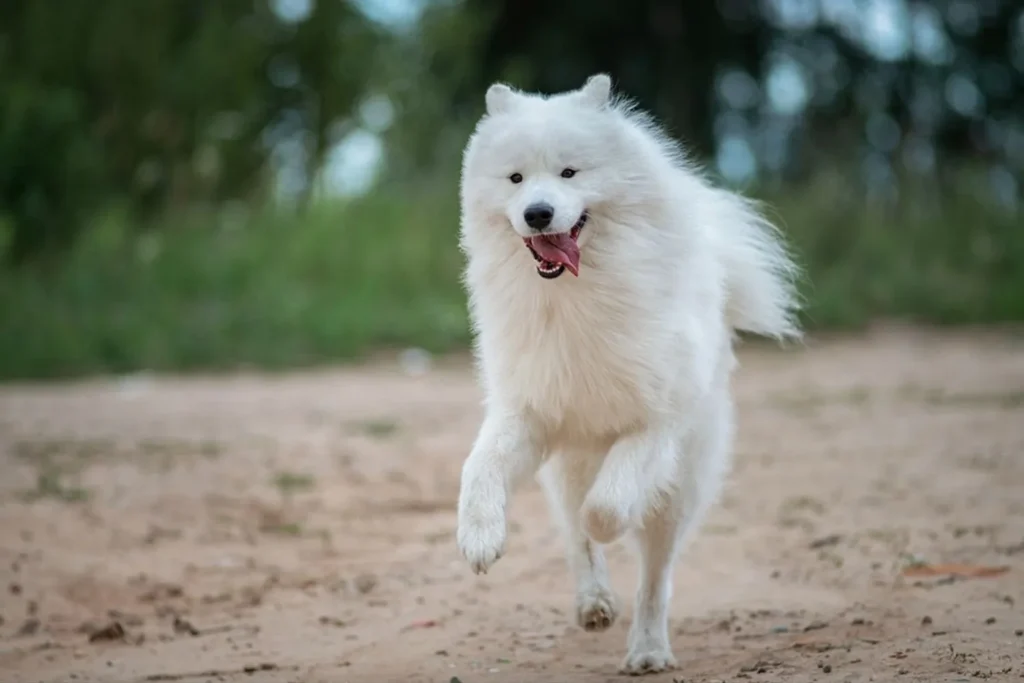
Samoyed FAQs: Smart, Loyal, and Lively
How intelligent are Samoyed dogs compared to other dogs?
Samoyeds are no slouches in the smarts department. They’re considered relatively intelligent compared to other breeds, ranking 33rd overall, and they often feel like living with a very bright toddler about 2 to 2.5 years old in “kid terms.” While they can’t tell you what they’re thinking, they genuinely seem to grasp a lot. Many can learn more than 150 words, and their number sense can stretch to around 4 or 5-handy when you’re counting treats and they’re counting, too.
What really stands out is their knack for problem solving and, honestly, mischief. They learn routines fast and can outwit other pets (and yes, their humans). I once tried the old “three cups and a treat” game, thinking I’d impress my Samoyed. She watched me shuffle, locked eyes with me like she knew my next move, and nosed the right cup every time. If you don’t want a fluffy mastermind opening the pantry, invest in baby locks and keep training games varied and fun. They thrive when their brains are busy: puzzle feeders, hide and seek, or asking them to fetch specific toys by name all make them beam with that famous Sammy smile.
Are Samoyeds known for being a loyal dog breed?
Absolutely. Samoyeds are devoted companions who form deep bonds with their people and families. They’re lively, sociable, and generally wonderful with older children who understand how to interact respectfully. In day to day life, they tend to be “velcro dogs” the kind who curl up at your feet while you work and follow you from room to room. Mine used to sleep by the bathroom door like a furry little bodyguard.
They love company, so a family home suits them perfectly. Expect enthusiastic greetings, a happy tail, and a dog who wants to be part of your plans. They’ll usually announce visitors with a cheerful bark, then make friends quickly. If you’ve got younger kids, just remember the basics: supervise, teach gentle play, and give your Samoyed a quiet spot to retreat to when needed. Their loyalty runs deep, and they often try to “help” around the house mine once proudly delivered a sock to every family member like it was a gift.
Can a new dog owner train Samoyed puppies?
Yes new dog owners can absolutely train Samoyed puppies but bring patience and a sense of humor. Start as soon as your pup comes home so they learn what’s acceptable right from the beginning. Samoyeds are high energy and clever, which is a fun combo if you channel it and a challenge if you don’t. They can get bored quickly, so short, upbeat sessions work best. Think five to ten minutes, a few times a day, with lots of praise and rewards.
Make training a game. Use treats sometimes, toys other times, and always your happy voice. Obedience basics, daily exercise, and mental stimulation are non negotiable for this breed. A few tips I swear by:
– Rotate training cues so they don’t check out.
– Mix in sniffy walks and puzzle toys to tire their brains.
– Practice recall with a long line in safe areas.
– Reward calm behavior around distractions don’t wait for perfection to praise.
– Socialize early and often: friendly dogs, different people, new surfaces, and sounds.
One time in puppy class, my Samoyed was doing sits and downs just fine, then suddenly decided the instructor’s shoelaces were the real lesson. We switched to a game of “touch” (nose to hand) and got her focus back instantly. The trick with Samoyeds is to stay enthusiastic and flexible. If you keep it fun, they’ll meet you halfway and sometimes surprise you with how quickly they learn.
How do I decide whether a Samoyed puppy is the best type of dog for me?
Choosing a dog is more than falling for a fluffy face. With Samoyeds, you’re signing up for brains, bounce, and a double coat that sheds like it has a second job. Purebred Samoyeds can be harder to train if you don’t keep things interesting, and grooming is a real responsibility. Their coat requires regular brushing, and during seasonal “coat blow,” you’ll swear you’re making a new dog out of the fluff you collect. I keep a brush by the door and a vacuum that’s earned its keep.
That said, from a reputable breeder or a Samoyed rescue, you’ll likely meet a lovable, generally healthy dog with a sunny disposition. They’re popular for good reason: they’re beautiful, friendly, and full of personality. Before you decide, ask yourself:
– Do I have time every day for exercise, play, and training?
– Am I okay with dog hair on my clothes, my couch, and probably my soul?
– Do I enjoy an engaging, sometimes cheeky dog who wants to be involved?
If you want a friendly, fluffy companion who will join your adventures and keep you on your toes, a Samoyed could be your perfect match. Visit a breeder or rescue, meet adult Samoyeds, chat with owners, and see the breed in action. The right match feels easy like that moment a smiling white cloud trots over, leans into your legs, and you realize you’ve just met your new best friend.
Disclaimer:
This article is for informational purposes only and doesn’t replace professional veterinary or training advice. Always consult a certified vet or dog trainer for guidance specific to your pup.
